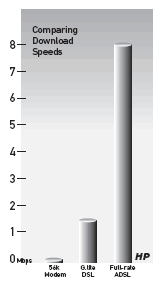September 2000
If you're ready to graduate from the annoyances of dial-up Internet service- namely the frequent busy signals and slow downloads of photos and shareware, not to mention the lengthy series of tones and squawks emanating from your modem- consider DSL.
With DSL(Digital Subscriber Line) service, your computer is always connected to the Internet via the service provider. That means no dialing, no waiting. Better yet, DSL data-transfer rates are up to 140 times faster than those of state-of-the-art 56k analog modems. With DSL service you'll be able to surf the Web and download music, photos and other large data files with blazing speed. DSL also enables computers to receive broadcast-quality video and handle bi-directional video-conferencing applications.
DSL service works through ordinary copper telephone wiring. In fact, a single pair of phone wires can carry voice and data transmissions simultaneously-you can talk on the phone and surf the Web at the same time on the same line. DSL works by splitting the phone line into two frequency ranges; frequencies below 4kHz are reserved for voice, and those above that for data.
 "Over a single, ordinary phone line, DSL can allow users to talk on the phone and browse the vast resources of the Internet," says Bill Rodey, vice chairman and treasurer of the DSLForum, an industry group formed to disseminate information and promote the technology. "More important, DSL has vast potential for virtually everyone who connects to the Internet. It brings higher access speeds, lower costs and is now broadly available to consumers," says Rodey.
"Over a single, ordinary phone line, DSL can allow users to talk on the phone and browse the vast resources of the Internet," says Bill Rodey, vice chairman and treasurer of the DSLForum, an industry group formed to disseminate information and promote the technology. "More important, DSL has vast potential for virtually everyone who connects to the Internet. It brings higher access speeds, lower costs and is now broadly available to consumers," says Rodey.
Provided that you have a phone line and a computer, all you need to get DSL service at your home or office is to contact a DSL provider. Most phone companies that provide Internet service now offer DSL, as do other Internet service providers.
One proviso: Your home's internal telephone wiring must be adequate to handle the increased speed. If your home phone lines are not Category 5 cable or better, consider upgrading them to get the most from your DSL service.
The DSL provider will arrange a service call to install a DSL modem and, in some cases, a filter on the phone line to separate voice from data.
There may be a one-time charge for the DSL modem, although some service providers offer them at reduced rates or free to long-term subscribers. Increasingly consumers will be able to purchase and install a DSL modem themselves, without a service call from the provider. Monthly fees for DSL vary with the provider and level of service, and are somewhat higher than for conventional Internet access, but generally are not prohibitive.
Not all DSL services are created equal. To begin with, there are actually several different types of DSL that perform in different ways, each meant for different types of users and applications. ADSL (Asymmetric Digital Subscriber Line) is the most common type for home and office use. ADSL offers faster download speed than upload speed and is appropriate for users who typically receive more large data files than they send. Full-rate ADSL downloads data at 8 Mbps (megabits per second) and uploads at speeds of up to 1 Mbps.
But because full-rate DSL is faster and more costly than most users need, a new standard called G.lite or DSL Lite, sanctioned by the International Telecommunications Union, is expected to be widely adopted soon. G.lite DSL offers download speeds up to 1.5 Mbps and uploads at up to 384 kbps (kilobits per second)-or 25 times faster than the fastest analog modem available today. Among the other types of DSL available today, there's SDSL (Symmetric Digital Subscriber Line) with which download and upload speeds are equal. SDSL might be desirable if you were hosting a Web site or engaged in another business application in which you needed to transmit high volumes of data from your computer.
For more information about DS Land to research providers in your area, visit dsllife.com.
